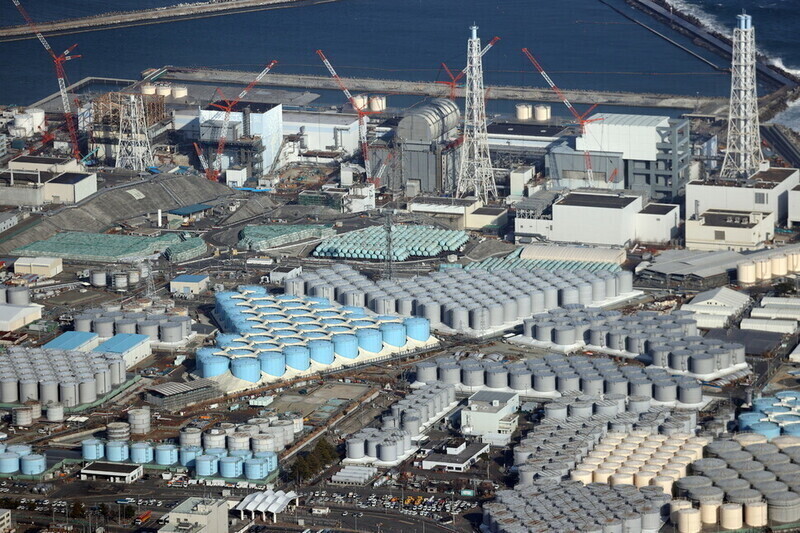hankyoreh
Links to other country sites 다른 나라 사이트 링크
[Column] Is dumping contaminated Fukushima water our best option?


Last November, the Tokyo Electric Power Company published a radiological impact assessment on its plan to release contaminated water from the Fukushima nuclear power plant. The report stated that if the concentration of 62 radionuclides in the contaminated water is lowered below the accepted limit using the Advanced Liquid Processing System, or ALPS, and if tritium is diluted with water and released at a lower concentration, local residents will only be exposed to a very small amount of radiation. But is releasing the contaminated water into the ocean really our best option?
TEPCO’s report overlooks several important issues. First, it completely fails to account for the contamination of the marine ecosystem and human radiation exposure that resulted from radionuclides that were released into the ocean and settled to the seabed in the initial phase of the Fukushima nuclear disaster. A large amount of contaminated water was discharged directly into the ocean during that phase, before the underground ice wall was built.
As a result, radiation levels on the seafloor are said to be relatively high, even though seawater radiation near Fukushima has returned to pre-meltdown levels 10 years after the disaster. There are still large amounts of various radionuclides near the seafloor, and they sometimes migrate into ecosystems populated by marine life. Therefore, our calculation of the amount of radiation to which residents will be exposed should be based not only on the contaminated water that the Japanese government plans to discharge but also on the radionuclides that have accumulated on the seafloor since the disaster itself.
Second, the claim that discharging contaminated water into the ocean will free up more land for decontaminating the nuclear plant isn’t sound. At the end of 2020, Japan’s Nuclear Regulation Authority announced that 70 petabecquerels of cesium, a radioactive material, had been detected near the shield plugs containing Fukushima reactors No. 2 and No. 3. That was double or triple the amount released into the atmosphere during the accident, and it’s expected to delay the decontamination work.
Until the decontamination work is complete, radionuclides from the damaged nuclear fuel will keep leaking into the coolant. In short, contaminated water continues to be generated. Therefore, the time it takes to discharge the contaminated water may have to be extended from 30 years to 60 years.
The amount of contaminated water being generated is equal to the amount being discharged under the Japanese plan. Whether water is released into the ocean over 30 years or even 60 years, therefore, the site will remain in its current state, precluding any effort to free up a meaningful amount of land.
Third, there are no contingency plans in place for the possibility that highly radioactive water — which accounts for 70% of the contaminated water stored in on-site tanks — may leak during a disaster. Even more urgent than discharging the radioactive water is carrying out another round of purification as soon as possible to prevent a leak of this highly radioactive water.
In addition to tritium, the highly contaminated water at the Fukushima plant contains radionuclides such as cesium (137Cs), strontium (90Sr) and iodine (129I). The debate has focused on tritium thus far, but there also needs to be an in-depth assessment of these other radionuclides.
A radionuclide with a short half-life exhibits a markedly reduced risk over time. For example, the tritium issue could be resolved simply by storing it in the tanks for longer. With a half-life of 12 years, 60 years of storage would reduce its radiation by 97%.
Rather than focusing on discharging the contaminated water into the ocean, we need to purify the highly radioactive water as soon as we can and secure more space for storing the contaminated water for at least 60 years. That’s a reasonable approach that would alleviate the concerns of the residents of Fukushima and neighboring countries without polluting the marine environment, which is a precious resource for us all.
Please direct questions or comments to [english@hani.co.kr]

Editorial・opinion
![[Column] Season 2 of special prosecutor probe may be coming to Korea soon [Column] Season 2 of special prosecutor probe may be coming to Korea soon](https://flexible.img.hani.co.kr/flexible/normal/500/300/imgdb/original/2024/0426/3317141030699447.jpg) [Column] Season 2 of special prosecutor probe may be coming to Korea soon
[Column] Season 2 of special prosecutor probe may be coming to Korea soon![[Column] Park Geun-hye déjà vu in Yoon Suk-yeol [Column] Park Geun-hye déjà vu in Yoon Suk-yeol](https://flexible.img.hani.co.kr/flexible/normal/500/300/imgdb/original/2024/0424/651713945113788.jpg) [Column] Park Geun-hye déjà vu in Yoon Suk-yeol
[Column] Park Geun-hye déjà vu in Yoon Suk-yeol- [Editorial] New weight of N. Korea’s nuclear threats makes dialogue all the more urgent
- [Guest essay] The real reason Korea’s new right wants to dub Rhee a founding father
- [Column] ‘Choson’: Is it time we start referring to N. Korea in its own terms?
- [Editorial] Japan’s rewriting of history with Korea has gone too far
- [Column] The president’s questionable capacity for dialogue
- [Column] Are chaebol firms just pizza pies for families to divvy up as they please?
- [Column] Has Korea, too, crossed the Rubicon on China?
- [Correspondent’s column] In Japan’s alliance with US, echoes of its past alliances with UK
Most viewed articles
- 1‘We must say no’: Seoul defense chief on Korean, USFK involvement in hypothetical Taiwan crisis
- 2AI is catching up with humans at a ‘shocking’ rate
- 3S. Korea “monitoring developments” after report of secret Chinese police station in Seoul
- 4The dream K-drama boyfriend stealing hearts and screens in Japan
- 5[Column] Can we finally put to bed the theory that Sewol ferry crashed into a submarine?
- 6[Editorial] Yoon cries wolf of political attacks amid criticism over Tokyo summit
- 7Doubts remain over whether Yoon will get his money out of trip to Japan
- 8[Photo] “Comfort woman” survivor calls on president to fulfill promises
- 9[Editorial] Was justice served in acquittal of Samsung’s Lee Jae-yong?
- 10Is N. Korea threatening to test nukes in response to possible new US-led sanctions body?